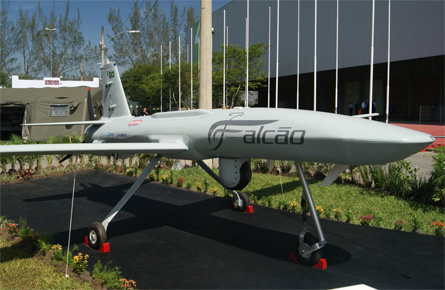Brazil has revealed plans for testing the Avibras Falcao, the country's most ambitious unmanned air vehicle project to date.
The 600kg (1,320lb)-class UAV is being prepared to achieve first flight in the second quarter of this year, and perhaps even before May, according to military and supply chain officials.
The Falcao's first flight will launch the second phase of Project VANT (the Portuguese-language acronym for UAV).
 |
|---|
© Stephen Trimble/Flightglobal |
In the two-year-long first phase, the Brazilian air force's department of aerospace science and technology (CTA) completed 59 flights with 1980s-vintage Acaua and Harpia UAVs.
Phase one validated the centre's navigation software, said Flavio Araripe, the CTA's Project VANT co-ordinator, speaking at the Latin America Aerospace and Defense 2011 show in early April.
For the second phase, the Falcao UAV will demonstrate the CTA's autonomous take-off and landing system, Araripe says.
Araripe did not describe details of the CTA's autonomous technology, but a sign next to Avibras's full-scale mock-up described the Falcao's ATOL system as "based on a radar altimeter with [differential GPS]".
The Falcao is also described by Avibras marketing materials as carrying a 150kg payload, including a satellite communication antenna, electro-optical sensor and synthetic aperture radar.
With the satellite communications antenna engaged, the Falcao has a listed operational range of 1,350nm (2,500km). The range with a line-of-sight datalink drops to 80nm.
With the ability to fly 15h missions at 15,000ft (4,570m), the Falcao is intended to be used for army surveillance missions, Araripe says. The CTA also is designing the Falcao to have air force applications, he adds.
At the same time, the Brazilian air force has already acquired a different UAV in the same class.
Araripe says that the air force's first UAV squadron will be established by the end of April, flying two Hermes 450 UAVs supplied by Elbit Systems subsidiary Aeroelectronica (AEL) in Brazil.
Embraer, meanwhile, has formed a joint venture with AEL to modify the Hermes 450 for Brazilian missions. The modifications could lead to dramatic changes in the design's configuration.
For Brazil, one of the driving performance requirements is range. Ran Hallerstein, executive vice-president and co-general manager of Elbit Systems Aerospace, says that need could prompt the Embraer/AEL joint venture to boost the current range of the Hermes 450.
"The Hermes 450 has a 150km range and they need 1,500km because Brazil is big," Hallerstein says. "We will figure out how to solve it."
Source: Flight International























